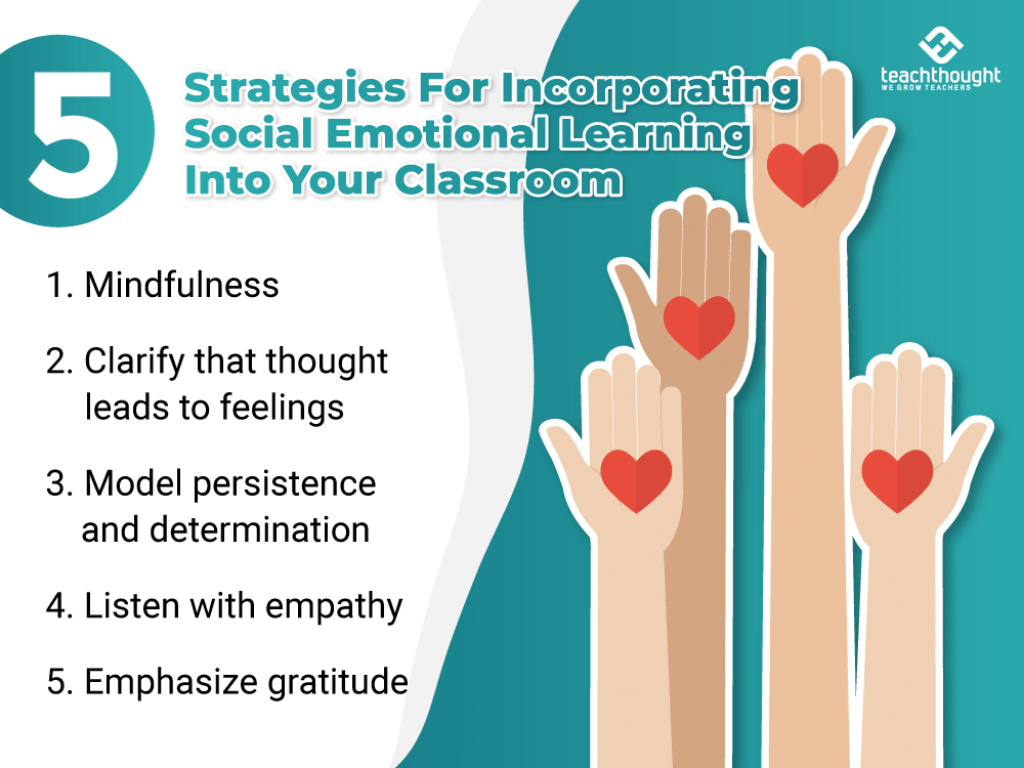Social Emotional Learning Strategies for the Classroom


Contributor Meg PriceEI experience
Social-emotional learning (SEL) is defined as the process of learning life skills, including how to deal with yourself, others, and relationships, and how to work effectively.
While there are many great SEL programs, SEL can also be integrated into every lesson as a way to teach students how to use skills in a variety of situations and form positive habits. All students start school with a certain level of social and emotional skills, and all develop their social and emotional skills at different rates.
Parents and teachers alike have a responsibility to teach students life skills, and of course much of what they learn is learned by observing our actions. The following five strategies are not only beneficial for students’ social-emotional learning, but also for teachers’ well-being.
See The benefits of social-emotional learning
5 strategies for incorporating social-emotional learning into your classroom
1. Through mindfulness
Mindfulness is: paying attention in a specific way, on purpose, in the present moment, and without judgment.
We are hearing more and more about the benefits of mindfulness for children. Increased attention can lead to better academic performance and improved emotional and social intelligence. Children are better able to learn, nurture themselves and become aware of their emotional needs.
Mindfulness exercises help students focus on their breath, body, thoughts, feelings, and the world around them. When they are able to observe their own thoughts and feelings, they are free to choose how they say and behave, which can make the classroom a happier, more harmonious place.
There are many free mindfulness activities, for example on YouTube. In addition, mindfulness and meditation app A framework for getting started can be provided. Why not start each class with a different mindfulness activity?
2. Clarify thoughts leading to feelings
Research shows that students who are more resilient are more successful academically. Resilient students bounce back more quickly, are aware of their thoughts, understand their beliefs, and more importantly are able to challenge their beliefs and ideas to create more positive outcomes.
This is an important concept because we may not always be able to influence what happens to us, but we do have a powerful influence on how we interpret what happens to us and how we deal with it. Many students don’t realize that their thoughts play an important role in influencing how they feel.
No matter what happens to you, no one can take it away from you. It’s a powerful lesson every time you hear students express frustration, anger, and other negative emotions. As a teacher, you can help by listening to emotions and then helping your students understand where that emotion comes from and how to adjust their thinking to contribute to their social-emotional well-being.
3. Model persistence and certainty
A very important aspect of well-being and SEL is the ability to get things done in life. Many students naturally strive to improve themselves in some way, whether they want to master a skill, achieve a worthwhile goal, or win at some competitive activity.
Other students need some guidance in this area. It is important to teach students that every lesson requires effort, patience, and perseverance. In this area of SEL, praise for effort is critical. Each student needs to be encouraged to set stretch goals during the course to gain a sense of achievement.
By being mindful and challenging negative thoughts, students can be encouraged to dig deep to find the determination to succeed.
4. Listen with empathy
In other words, listen and be surprised.
Part of SEL is understanding the importance of positive relationships. In order to build these relationships, we need to have and teach empathy. Teachers have a remarkable ability to model empathy. Encourage students to listen to others, then ask them to be surprised to hear and understand how other students are feeling. What opportunities are there in each class for students to find new ways to help each other and learn from other people’s ideas?
Use opportunities in class to teach students to ask questions that encourage responses rather than defensiveness. For example, when John says, “Sam, why can’t you follow the instructions?” John is encouraged to reframe his question to better understand what Sam is seeking. “Sam, can we go through these instructions together to make sure they make sense?
Tone is very important in teaching.
5. Emphasize gratitude
Research shows us once again that a really important aspect of happiness is gratitude. This study shows that people who regularly express gratitude have more energy and enthusiasm, are less stressed, and have better physical health. There are some very simple ways to increase your experience and express gratitude; however, this may require us to train ourselves to think differently.
For students, this can be accomplished by incorporating some simple exercises into each lesson. At the end of each class, students are asked to reflect on the class using the following three questions:
– What did you like about today’s class?
– Who did you enjoy working with today?
– Which areas of this topic would you like to learn more about?
Most importantly, every class is fun; learning should be fun, and play is a very important part of social-emotional learning!



